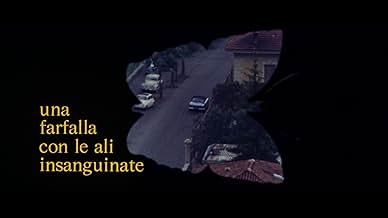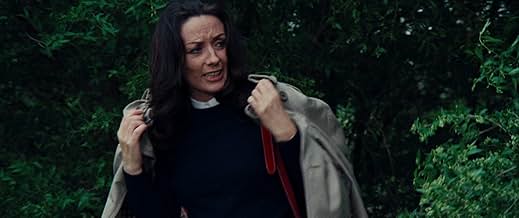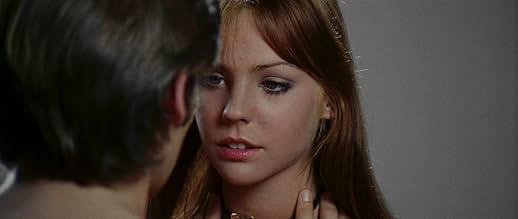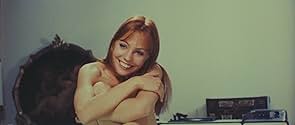Un papillon aux ailes ensanglantées
Original title: Una farfalla con le ali insanguinate
IMDb RATING
6.3/10
2.2K
YOUR RATING
A popular television presenter is accused of killing a teenage girl in a park, who happens to be his daughter's best friend.A popular television presenter is accused of killing a teenage girl in a park, who happens to be his daughter's best friend.A popular television presenter is accused of killing a teenage girl in a park, who happens to be his daughter's best friend.
Ida Galli
- Maria Marchi
- (as Evelyn Stewart)
Wendy D'Olive
- Sarah Marchi
- (as Wendi D'Olive)
Gabriella D'Olive
- Gabriella Giusti
- (as Gabriella Venditti)
Antonio Anelli
- Journalist
- (uncredited)
Gisella Burinato
- The forensic Chemist
- (uncredited)
Featured reviews
Duccio Tessari is probably best known as the director of several Spaghetti Westerns, most prominently the "Ringo" films with Giuliano Gemma, as well as the well-known Italian Crime flick "Tony Arzenta". The man also served as an (uncredited) co-writer of Sergio Leone's Italian Western milestone "Fistful of Dollars", and as a writer of several sword and sandal films in the early 60s. As a director, Tessari's doubtlessly best films are his two intelligent and plot-driven Gialli, "L'Uomo Senza Memoria" (aka. "The Man Without Memory", 1974) and this gem. "Una Farfalla Con Le Ali Insanguiante" aka. "Bloodstained Butterfly" of 1971 is a terrific, beauty- and suspenseful example for a purely plot-based Giallo that profits from an excellent cast, a great score, wonderful settings and a sublime cinematography. As it is the case with Tessari's other Giallo, "The Man Without Memory", "Bloodstained Butterfly" is a Giallo that focuses on the Mystery more than the Horror-elements of the genre. And the film is indeed a perfectly constructed puzzle of a mystery that is (though convoluted) always easy to follow.
When a French exchange student (Carole André) is murdered by multiple stabbing in a park in Bergamo, the police arrest TV anchor Marchi (Giancarlo Sbragia). Marchi's daughter Sarah (Wendy D'Olive), who was friends with the murdered girl, does not believe in her father's guilt... As said above, this is a purely story-driven Giallo. For genre-standards, there are only very few murders and very little gore. The film is very suspenseful, however, and delivers mystery and innovative twists from the beginning to the end, as a good Giallo should. The beautiful Bergamo locations are a wonderful setting for the film, which is furthermore (in good Giallo-tradition) brilliantly photographed. The beautiful score intensifies the atmosphere, and the film profits from a very good ensemble cast. The characters are all complex and elaborate. The always-sinister Helmut Berger and Italian Grenre-cinema regulars such as Ida Galli ("The Case Of The Scorpion's Tail"), Günter Stoll ("What Have They Done To Solange"), Silvano Tranquilli ("The Black Belly of The Tarantula"), and Giancarlo Sbragia ("Tony Arzenta") all deliver very good performances. As said, for a Giallo this features little violence and gore and also little sleaze, but the magnificently elaborate plot should be more than pleasant to Genre-fans. "Bloodstained Butterfly" is beautifully filmed with a lot of style, and highly recommended to my fellow Giallo-fans.
When a French exchange student (Carole André) is murdered by multiple stabbing in a park in Bergamo, the police arrest TV anchor Marchi (Giancarlo Sbragia). Marchi's daughter Sarah (Wendy D'Olive), who was friends with the murdered girl, does not believe in her father's guilt... As said above, this is a purely story-driven Giallo. For genre-standards, there are only very few murders and very little gore. The film is very suspenseful, however, and delivers mystery and innovative twists from the beginning to the end, as a good Giallo should. The beautiful Bergamo locations are a wonderful setting for the film, which is furthermore (in good Giallo-tradition) brilliantly photographed. The beautiful score intensifies the atmosphere, and the film profits from a very good ensemble cast. The characters are all complex and elaborate. The always-sinister Helmut Berger and Italian Grenre-cinema regulars such as Ida Galli ("The Case Of The Scorpion's Tail"), Günter Stoll ("What Have They Done To Solange"), Silvano Tranquilli ("The Black Belly of The Tarantula"), and Giancarlo Sbragia ("Tony Arzenta") all deliver very good performances. As said, for a Giallo this features little violence and gore and also little sleaze, but the magnificently elaborate plot should be more than pleasant to Genre-fans. "Bloodstained Butterfly" is beautifully filmed with a lot of style, and highly recommended to my fellow Giallo-fans.
I love that in the seventies, you could pull up to a petrol station get out next to the pumps, try and light up a cigarette, find out the packet is empty, throw the empty packet on the ground, then go and pick up a hooker.
This seems to be a blend of the old school gialli (rich, soulless socialites double crossing each other) and the new gialli (gloved killer, stabbing) that has a middle part that centres around a murder prosecution. You might need a little patience.
After we're introduced to our characters with their names appearing onscreen beside them, we see a girl's corpse tumbling down a hill in a park and being found by two kids. Several witnesses spot a person in a mac stumbling through the park, with one lady claiming that the killer is a well known television personality whose daughter coincidentally it the murdered girl's best friend. However, a dazed Helmet Berger is seen staggering around the place too, so we know that things are going to get convoluted pretty quickly.
Cop Silvio Tranquilli is brought in to...well, not break these case as they get a suspect pretty quickly, but he does complain about coffee a lot. Plus, this whole sequence gives director Duccio Tessari a chance to give us all sorts of freaky camera angles while the police use scientific methods that seems to quickly lead to a healthy case to send down the TV presenter.
However, the suspect also has a pretty good lawyer who may very well get him off the hook. Well, nearly. After the presenter's wife (Ida Galli) accidentally gets the guy sent down, things get very giallo like as true motives are revealed, the double crosses begin, and the murders seemingly continue, even though the killer is in jail.
To give you an idea of the pace of this film, the police are still standing over the first victim's body eighteen minutes into the film. Then you get the courtroom drama and the mystery of what Helmet Berger has to do with it all. Duccio Tessari is no fool, however. His eye for good visuals shines through and we get a change of scenery as the film is set in Bologna, not a place that turns up frequently in these films.
It does drag, but the ending is worth waiting for. I'd been after this one for ages and although it's good, I don't think I'd ever watch it again.
This seems to be a blend of the old school gialli (rich, soulless socialites double crossing each other) and the new gialli (gloved killer, stabbing) that has a middle part that centres around a murder prosecution. You might need a little patience.
After we're introduced to our characters with their names appearing onscreen beside them, we see a girl's corpse tumbling down a hill in a park and being found by two kids. Several witnesses spot a person in a mac stumbling through the park, with one lady claiming that the killer is a well known television personality whose daughter coincidentally it the murdered girl's best friend. However, a dazed Helmet Berger is seen staggering around the place too, so we know that things are going to get convoluted pretty quickly.
Cop Silvio Tranquilli is brought in to...well, not break these case as they get a suspect pretty quickly, but he does complain about coffee a lot. Plus, this whole sequence gives director Duccio Tessari a chance to give us all sorts of freaky camera angles while the police use scientific methods that seems to quickly lead to a healthy case to send down the TV presenter.
However, the suspect also has a pretty good lawyer who may very well get him off the hook. Well, nearly. After the presenter's wife (Ida Galli) accidentally gets the guy sent down, things get very giallo like as true motives are revealed, the double crosses begin, and the murders seemingly continue, even though the killer is in jail.
To give you an idea of the pace of this film, the police are still standing over the first victim's body eighteen minutes into the film. Then you get the courtroom drama and the mystery of what Helmet Berger has to do with it all. Duccio Tessari is no fool, however. His eye for good visuals shines through and we get a change of scenery as the film is set in Bologna, not a place that turns up frequently in these films.
It does drag, but the ending is worth waiting for. I'd been after this one for ages and although it's good, I don't think I'd ever watch it again.
Though Mario Bava had gotten the Giallo ball rolling in 1964 with "Blood And Black Lace" (though some may argue that it was really 1962's "Evil Eye/ The Girl Who New Too Much" that was really the first Giallo), it wasn't really until Dario Argento's 1969 masterpiece "The Bird With The Crystal Plumage" that started the Italian Production trend. But between 1970 to 1972 it was in it's full swing!
They must have been throwing these films out weekly! But Duccio Tessari's 1971 Giallo "The Bloodstained Butterfly" is a standout for many reasons. First it takes a slightly different approach in it's proceedings, anouncing the characters names like an Agatha Christie thriller. It contains a lush hypnotic soundtrack supplied by Gianni Ferrio (that blends out of a jarring Tchaikovsky number), that fits in snuggly with Ennio Morricone's doodlings (yet retains it's own originality). The entire cast is solid, with Helmut Berger's Giorgio (a pianist) going mental every time he hears Tchaikovsky, and Giancarlo Sbragia (the main suspect) looking timid (yet shifty) while trying to defend himself. Red herrings abound (everyone seems slightly guilty and slimey) the story weaves a web of perplexity until the surprising (or not so surprising if you've seen enough Giallos) climax. Dementia out of passion is called into explanation, and this is not just your regular moral avenger or greedy interloper Giallo. Beautiful Wendy D'Olive plays the daughter of the suspect (the only character who isn't dipped in slime), and one can't help but feel that this poor character will probably suffer a nervous breakdown at the end of the chaos. To give away the story would be a crime, because this is what keeps the interest jumping. Again the black gloved assassin is taking the lives of beautiful women, but this tends to feel like a more mature outing with restrained gore. The emphasis is placed on the convoluted, puzzling story. One thing that makes Giallo films so great is that it's stylized trash. Not simply just stalk n' slash fair (unlike so many of America's horror films of the time), but great detail is placed on locations, clothes, interior decoration, and music. Giallo films tend to seduce (before destroying) it's viewer with everything abound incorporating a lushous veneer.
"Bloodstained Butterfly" is a prime example of this asthetic. One of my favourite moments of the film is when Wendy D'Olive is taking a tram through the city, while Helmut Berger is driving his sports car right before their chance (or maybe it isn't?) meeting. The wonderful music glides you through the scene like an Italian daydream, only to drop you into a scene of suspicion. Highly recommended for fans of Italian Cinema!
They must have been throwing these films out weekly! But Duccio Tessari's 1971 Giallo "The Bloodstained Butterfly" is a standout for many reasons. First it takes a slightly different approach in it's proceedings, anouncing the characters names like an Agatha Christie thriller. It contains a lush hypnotic soundtrack supplied by Gianni Ferrio (that blends out of a jarring Tchaikovsky number), that fits in snuggly with Ennio Morricone's doodlings (yet retains it's own originality). The entire cast is solid, with Helmut Berger's Giorgio (a pianist) going mental every time he hears Tchaikovsky, and Giancarlo Sbragia (the main suspect) looking timid (yet shifty) while trying to defend himself. Red herrings abound (everyone seems slightly guilty and slimey) the story weaves a web of perplexity until the surprising (or not so surprising if you've seen enough Giallos) climax. Dementia out of passion is called into explanation, and this is not just your regular moral avenger or greedy interloper Giallo. Beautiful Wendy D'Olive plays the daughter of the suspect (the only character who isn't dipped in slime), and one can't help but feel that this poor character will probably suffer a nervous breakdown at the end of the chaos. To give away the story would be a crime, because this is what keeps the interest jumping. Again the black gloved assassin is taking the lives of beautiful women, but this tends to feel like a more mature outing with restrained gore. The emphasis is placed on the convoluted, puzzling story. One thing that makes Giallo films so great is that it's stylized trash. Not simply just stalk n' slash fair (unlike so many of America's horror films of the time), but great detail is placed on locations, clothes, interior decoration, and music. Giallo films tend to seduce (before destroying) it's viewer with everything abound incorporating a lushous veneer.
"Bloodstained Butterfly" is a prime example of this asthetic. One of my favourite moments of the film is when Wendy D'Olive is taking a tram through the city, while Helmut Berger is driving his sports car right before their chance (or maybe it isn't?) meeting. The wonderful music glides you through the scene like an Italian daydream, only to drop you into a scene of suspicion. Highly recommended for fans of Italian Cinema!
One of the best gialli to come out of Italy in the 1969-77 period, it's very stylish and (of course) convoluted, but always interesting and ultimately quite clever. For once the solution to the mystery actually matters (and makes sense!), and the motive behind the murders and the finale are worthy of Agatha Christie. I highly recommend it. Great soundtrack too, I just bought the CD.
A girl is murdered in a park. A suspect is tried and convicted but the killings continue.
The Bloodstained Butterfly is a giallo that occupies the more restrained side of the genre. Despite having a plot revolving around a series of knife murders, it doesn't really focus on these killings. One is shown briefly in flash-back, while the others are essentially committed off-screen. Instead, the narrative concentrates more on the mystery. For this reason it is on the more sober and intelligent side of the giallo genre. Quite a bit of the story is taken up with the police procedural angle and court-room scenes. And similar to many others in the sub-genre, an intense melodrama underpins the murder mystery; and, as is often the case, it's populated by a group of quite unsympathetic people. These are made up with the usual concoction of the psychologically troubled and the sleazily untrustworthy.
While the emphasis on melodrama and detective/courtroom dynamics might not be to everyone's taste, it works here. The mystery is compelling and you are kept guessing all the way. I can't say I predicted the outcome either, which is always a bonus. But in amongst all of this are some great typical giallo moments such as the opening scenes in the park with the killer making a get away shot from a number of nice angles. In general, as you might expect from this type of film it is photographed well throughout and has a good soundtrack too. It also has a somewhat unusual opening credit sequence where we are introduced to all of the main characters where they are shown with their moniker displayed on screen. This is quite good, as these films almost always have convoluted plot-lines and this helps ease us into proceedings with a quick look at whose who in the film about to start.
The Bloodstained Butterfly is overall a pretty involving mystery. It isn't a horror-orientated thriller at all though, so if that's what you're after you'd be best looking elsewhere. But it has the specific mood and essence that early 70's gialli have. If you're a fan of the sub-genre you should check this one out.
The Bloodstained Butterfly is a giallo that occupies the more restrained side of the genre. Despite having a plot revolving around a series of knife murders, it doesn't really focus on these killings. One is shown briefly in flash-back, while the others are essentially committed off-screen. Instead, the narrative concentrates more on the mystery. For this reason it is on the more sober and intelligent side of the giallo genre. Quite a bit of the story is taken up with the police procedural angle and court-room scenes. And similar to many others in the sub-genre, an intense melodrama underpins the murder mystery; and, as is often the case, it's populated by a group of quite unsympathetic people. These are made up with the usual concoction of the psychologically troubled and the sleazily untrustworthy.
While the emphasis on melodrama and detective/courtroom dynamics might not be to everyone's taste, it works here. The mystery is compelling and you are kept guessing all the way. I can't say I predicted the outcome either, which is always a bonus. But in amongst all of this are some great typical giallo moments such as the opening scenes in the park with the killer making a get away shot from a number of nice angles. In general, as you might expect from this type of film it is photographed well throughout and has a good soundtrack too. It also has a somewhat unusual opening credit sequence where we are introduced to all of the main characters where they are shown with their moniker displayed on screen. This is quite good, as these films almost always have convoluted plot-lines and this helps ease us into proceedings with a quick look at whose who in the film about to start.
The Bloodstained Butterfly is overall a pretty involving mystery. It isn't a horror-orientated thriller at all though, so if that's what you're after you'd be best looking elsewhere. But it has the specific mood and essence that early 70's gialli have. If you're a fan of the sub-genre you should check this one out.
Did you know
- TriviaDuring pre-production, the film was promoted as an adaptation of an Edgar Wallace story. Less then two weeks before principal photography, the West German companies Rialto Film and Constantine Film (who were co-producing the movie) pulled out for unknown reasons, and any reference to Wallace was removed from the final film. The German connection is still reflected via Günther Stoll and Wolfgang Preiss, both stars of Rialto's Wallace adaptations (better known as 'krimi' films).
- GoofsIn the scene immediately following the credits, a woman with a couple of children playing in a park expresses concern that it's about to rain, pleading with the children repeatedly to stop their games and return home with her at once. A corpse rolls down in the bushes and the children turn around, only to see that the woman responsible for them has abandoned them, left in their dangerous circumstances, to run for the police.
- Quotes
Attorney Giulio Cordaro: We all know that in the park one finds a cesspool of voyeurs, thieves, homosexuals, and other unsavory types.
- ConnectionsFeatured in Mad Dog Helmut (2016)
- SoundtracksConcerto No. 1 for Piano and Orchestra
By Tschaikowsky
- How long is The Bloodstained Butterfly?Powered by Alexa
Details
- Runtime1 hour 39 minutes
- Aspect ratio
- 2.35 : 1
Contribute to this page
Suggest an edit or add missing content

Top Gap
By what name was Un papillon aux ailes ensanglantées (1971) officially released in India in English?
Answer



























